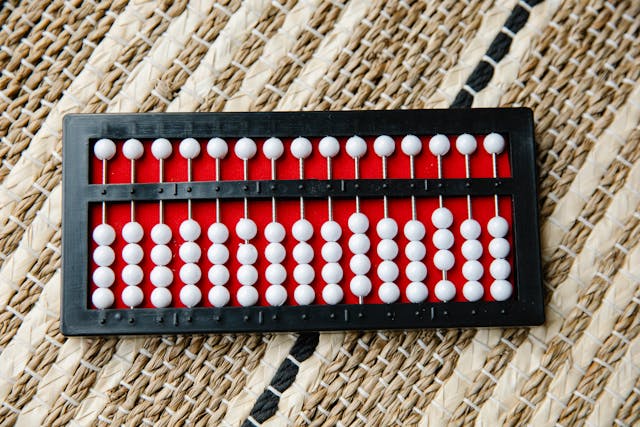
Why was the abacus invented? It was invented because merchants needed to keep an inventory, trade was taking off, and the powers that be wanted their tax..
The English word abacus came from the Latin word abax, which came from the Greek word abax, which meant table or tablet. It could have come from an even older Phoenician word, adj, that meant sand. The Greek and Roman words could have meant a table covered in dust or sand, which gives some idea of where the concept of the abacus came from.
The abacus evolved from a counting table, which would have been a simple way to keep track of goods. We probably have an image of an abacus as a frame with beads that can slide up and down on metal rods. However, the beads don’t have to be connected and the earliest forms of abacus had loose beads that were placed on the counting table. The earliest counting tables appeared in Mesopotamia in about 2700 BC.
An abacus is not just a counting device, it is a calculating device as well. Early humans began counting roughly 50,000 years ago. Bones have been found with marks in them that appear to be some kind of tally. There is no way of knowing what they were counting, but the fact that they were using symbols to represent numbers was a huge leap forward in our history. Being able to count and keep track of numbers was important, but there wasn’t really a need for any kind of calculating device until people started living together. In a small community, you can probably count high enough on just your fingers to keep track of the comings and goings. Large societies had to have an economy and a system of buying and selling. It was necessary to keep track of things and to be able to calculate costs and work out how much stock was left. It was also necessary to calculate tax. Making marks on bone wouldn’t work for such a fluid system, which is where the counting table came in.
The very first counting boards were probably just lines drawn in the sand on the floor, or maybe sand placed on a table. This could be why the word abacus came from the word for sand. Early counting boards were some kind of board with beads or pebbles on it. The board had columns that were carved into it. Each column represented a different place-value and the person doing the calculating would place beads or pebbles in the columns to represent the numbers. Incidentally, the Latin for pebble is calculi, which is where the word calculate comes from. No boards from before about 300 BC survive because wood doesn’t last that long. There are many boards that are made of metal or stone. They have grooves carved into them for the counters to be placed in. They were very sturdy, but it was impossible to move them.
In Roman times, a portable abacus was created. Rome was an empire that had a huge trade network and counting and tallying were vital. They created the hand abacus which is small enough to hold and has grooves carved in it for round counters that would be carried in a bag. The Roman hand abacus bears a lot of similarity to the Chinese abacus that was invented around about the same time. There is a lot of online discussion about whether they were separate inventions, or whether one influenced the other. Rome and China did have a lot of trade along the Silk Road, and it is not inconceivable that technology like the abacus could have spread. Did it go from Rome to China, or from China to Rome is something that we probably can’t find out. The Chinese abacus had the beads set on rods, which made the abacus much easier to carry and it also sped things up because there was no worry that the beads would fall off the tray if you calculated too quickly.
These days, we have no need for abacuses, but many people still like to use them. They are very popular in Asian countries and are taught in school. They can also help children learn math because they give a visual representation of the numbers. And that is what I learned today.
Photo by Eren Li: https://www.pexels.com/photo/close-up-photo-of-abacus-7188764/
Sources
https://www.ee.torontomu.ca/~elf/abacus/history.html
https://www.ee.torontomu.ca/~elf/abacus/roman-hand-abacus.html
https://en.wikipedia.org/wiki/Abacus
https://mathtimeline.weebly.com/early-human-counting-tools.html
